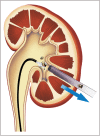Real-time simultaneous endoscopic combined intrarenal surgery with intermediate-supine position: Washout mechanism and transport technique
- PMID: 30182081
- PMCID: PMC6121022
- DOI: 10.4111/icu.2018.59.5.348
Real-time simultaneous endoscopic combined intrarenal surgery with intermediate-supine position: Washout mechanism and transport technique
Abstract
Endoscopic combined intrarenal surgery (ECIRS) with simultaneous retrograde intrarenal surgery (RIRS) and percutaneous nephrolithotomy (PCNL) has been proposed as a new surgical treatment to overcome the disadvantage of RIRS and PCNL monotherapies in the treatment of renal stone. One of advantages of ECIRS is that it can increase stone-free rates in complex renal stone within single-session. Intermediate-supine position in real-time simultaneous ECIRS can prevent an anesthesiologic problem, and patient's burden is small even for long-term operation. Thus, we will share the experience and advantages of real-time simultaneous ECIRS and introduce techniques to increase the stone-free rate.
Keywords: Kidney; Nephrolithiasis; Ureteroscopy; Urinary calculi.
Conflict of interest statement
CONFLICTS OF INTEREST: The authors have nothing to disclose.
Figures



References
-
- Türk C, Petřík A, Sarica K, Seitz C, Skolarikos A, Straub M, et al. EAU Guidelines on Interventional Treatment for Urolithiasis. Eur Urol. 2016;69:475–482. - PubMed
-
- Atis G, Culpan M, Pelit ES, Canakci C, Ulus I, Gunaydin B, et al. Comparison of percutaneous nephrolithotomy and retrograde intrarenal surgery in treating 20–40 mm renal stones. Urol J. 2017;14:2995–2999. - PubMed
Publication types
MeSH terms
LinkOut - more resources
Full Text Sources
Other Literature Sources
Medical

